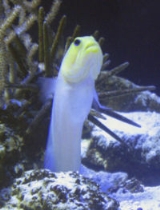
Yellowhead jawfish
Encyclopedia
The Yellow-headed jawfish (Opistognathus aurifrons) is found in coral reef
s in the Caribbean Sea
. The head and upper body are a light, but brilliant, yellow color slowly fading to a pearlescent blue hue. The mouth and jaws are, as suggested by the common name
, a signature of the jawfishes
.
It remains near its relatively small territory
, and is typically seen with only the head and upper section of its body protouding from its burrow
, although it sometimes can be found hovering nearby. It is able to arrange material using its mouth to carry sand, shells, or small rocks from one location to another, or removing them from its burrow, and placing them in more preferred locations.
It is a mouthbrooder
, with males carrying the eggs in the mouth until they hatch.
setting, provided they have a large enough habitat. In the aquarium
they feed on small planktonic matter, commonly taking brine shrimp
, mysis shrimp and prepared frozen and pelleted foods. When other fish come near its territory, it will open its jaw wide and try to warn them off, but rarely attacks.
Coral reef
Coral reefs are underwater structures made from calcium carbonate secreted by corals. Coral reefs are colonies of tiny living animals found in marine waters that contain few nutrients. Most coral reefs are built from stony corals, which in turn consist of polyps that cluster in groups. The polyps...
s in the Caribbean Sea
Caribbean Sea
The Caribbean Sea is a sea of the Atlantic Ocean located in the tropics of the Western hemisphere. It is bounded by Mexico and Central America to the west and southwest, to the north by the Greater Antilles, and to the east by the Lesser Antilles....
. The head and upper body are a light, but brilliant, yellow color slowly fading to a pearlescent blue hue. The mouth and jaws are, as suggested by the common name
Common name
A common name of a taxon or organism is a name in general use within a community; it is often contrasted with the scientific name for the same organism...
, a signature of the jawfishes
Opistognathidae
Opistognathidae , commonly referred to as jawfishes, are classified within Order Perciformes, Suborder Percoidei. They are found throughout shallow reef areas of the Atlantic and Pacific Oceans, and the Gulf of Mexico.Physically similar to blennies, jawfish are generally smaller-sized fish with an...
.
It remains near its relatively small territory
Territory (animal)
In ethology the term territory refers to any sociographical area that an animal of a particular species consistently defends against conspecifics...
, and is typically seen with only the head and upper section of its body protouding from its burrow
Burrow
A burrow is a hole or tunnel dug into the ground by an animal to create a space suitable for habitation, temporary refuge, or as a byproduct of locomotion. Burrows provide a form of shelter against predation and exposure to the elements, so the burrowing way of life is quite popular among the...
, although it sometimes can be found hovering nearby. It is able to arrange material using its mouth to carry sand, shells, or small rocks from one location to another, or removing them from its burrow, and placing them in more preferred locations.
It is a mouthbrooder
Mouthbrooder
Mouthbrooding, also known as oral incubation and buccal incubation, is the care given by some groups of animals to their offspring by holding them in the mouth of the parent for extended periods of time. Although mouthbrooding is performed by a variety of different animals, most notably Darwin's...
, with males carrying the eggs in the mouth until they hatch.
In the aquarium
Interesting behaviors can be observed when placed in a shoalShoaling and schooling
In biology, any group of fish that stay together for social reasons are said to be shoaling , and if, in addition, the group is swimming in the same direction in a coordinated manner, they are said to be schooling . In common usage, the terms are sometimes used rather loosely...
setting, provided they have a large enough habitat. In the aquarium
Aquarium
An aquarium is a vivarium consisting of at least one transparent side in which water-dwelling plants or animals are kept. Fishkeepers use aquaria to keep fish, invertebrates, amphibians, marine mammals, turtles, and aquatic plants...
they feed on small planktonic matter, commonly taking brine shrimp
Brine shrimp
Artemia is a genus of aquatic crustaceans known as brine shrimp. Artemia, the only genus in the family Artemiidae, has changed little externally since the Triassic period...
, mysis shrimp and prepared frozen and pelleted foods. When other fish come near its territory, it will open its jaw wide and try to warn them off, but rarely attacks.

